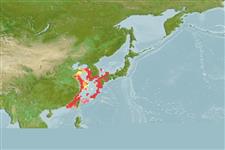>
Clupeiformes (Herrings) >
Dorosomatidae (Gizzard shads and sardinellas)
Etymology: Sardinella: Latin and Greek, sarda = sardine; name related to the island of Sardinia; diminutive (Ref. 45335).
More on author: Bleeker.
Environment: milieu / climate zone / depth range / distribution range
экология
морской; мигрирует в океане (Ref. 51243); пределы глубины 5 - ? m (Ref. 12166). Subtropical; 38°N - 22°N, 117°E - 134°E (Ref. 54873)
Western Pacific: southern coasts of Japan south to about Taiwan.
Size / Вес / Возраст
Maturity: Lm ? range ? - ? cm
Max length : 18.0 cm TL самец/пол неопределен; (Ref. 56557); common length : 10.0 cm SL самец/пол неопределен; (Ref. 188)
колючие лучи спинного плавника (общее число): 0; колючие лучи анального плавника 0. Total scutes 29 to 32. Vertical striae on scales overlapping or continuous (discontinuous in S. fimbriata and S. albella), only a few small perforations on hind part of scale. No dark spot at dorsal fin origin. Most closely resembles S. richardsoni, which has more gill rakers and has a slightly deeper body; S. hualiensis has black tips to dorsal and caudal fins.
Found near shore, including semi-enclosed sea areas, on sandy mud bottom (Ref. 11230). Forms schools in coastal waters. Used in Chinese medicine (Ref. 12166).
Whitehead, P.J.P., 1985. FAO Species Catalogue. Vol. 7. Clupeoid fishes of the world (suborder Clupeoidei). An annotated and illustrated catalogue of the herrings, sardines, pilchards, sprats, shads, anchovies and wolf-herrings. FAO Fish. Synop. 125(7/1):1-303. Rome: FAO. (Ref. 188)
Статус Красного Списка МСОП (Ref. 130435)
Угроза для людей
Harmless
Использование человеком
рыболовство: важный объект промысла
дополнительная информация
ссылкиаквакультура (рыбоводство)особенности рыбоводствастепень растяжениягенетикаElectrophoresesнаследуемостьболезниобработкаNutrientsMass conversion
соавторыизображенияStamps, Coins Misc.звукиCiguateraскоростьтип плаванияжаберная областьOtolithsмозгзрение
инструменты
Специальные отчеты
Скачать в формате XML
ресурсы в Интернет
Estimates based on models
Preferred temperature (Ref.
123201): 13 - 24.7, mean 19.7 °C (based on 72 cells).
Phylogenetic diversity index (Ref.
82804): PD
50 = 0.5000 [Uniqueness, from 0.5 = low to 2.0 = high].
Bayesian length-weight: a=0.01230 (0.00694 - 0.02182), b=3.06 (2.91 - 3.21), in cm total length, based on LWR estimates for this species & Genus-body shape (Ref.
93245).
Trophic level (Ref.
69278): 3.2 ±0.3 se; based on diet studies.
Generation time: 2.2 ( na - na) years. Estimated as median ln(3)/K based on 2
growth studies.
устойчивость к внешним воздействиям (Ref.
120179): высокий, минимальное время удвоения популяции до 15 месяцев (tm=1).
Fishing Vulnerability (Ref.
59153): Low vulnerability (22 of 100).
Climate Vulnerability (Ref.
125649): High vulnerability (63 of 100).
Nutrients (Ref.
124155): Calcium = 159 [86, 301] mg/100g; Iron = 1.78 [1.05, 3.19] mg/100g; Protein = 21.2 [20.2, 22.1] %; Omega3 = 0.475 [0.231, 0.905] g/100g; Selenium = 40.5 [21.3, 76.6] μg/100g; VitaminA = 22.7 [6.8, 75.7] μg/100g; Zinc = 0.796 [0.579, 1.188] mg/100g (wet weight);
